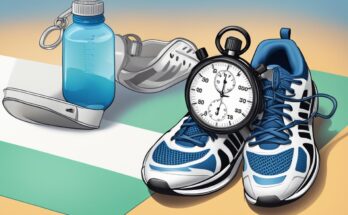Running is more than a physical activity; it’s a metaphor for the emotional journey of life with its peaks of joy and valleys of hardship. Runners experience a spectrum of highs and lows, not just in races or training sessions, but also in the personal growth and challenges that come with consistent commitment to the sport.

The highs in running can manifest as a palpable sense of achievement, the euphoria of surpassing personal records, or the profound satisfaction of enduring when every fiber of one’s being screams for respite. These moments serve as milestones, marking the joyous occasions when an individual’s efforts culminate in success. The joy derived from such accomplishments often resonates beyond the track or trail, energizing other aspects of life.
Conversely, the lows are an integral part of the runner’s journey, teaching resilience and humility. They come in the form of injuries, burnout, or the mental battles that ensue when motivation wanes. These periods test a runner’s resolve but also contribute to their growth, fortifying their mental toughness and underscoring the importance of rest and recovery. Both the highs and lows are essential to the runner’s story, shaping a narrative that extends well beyond the bounds of the sport itself.
The Psychology of Running

Running engages the mind as much as it does the body, influencing emotions, motivation, and confidence while requiring runners to navigate through both their highs and lows.
Emotional Rollercoaster
Runners often experience a broad spectrum of emotions from elation to frustration. Highs, such as the runner’s high, are characterized by feelings of happiness and a sense of achievement. On the other hand, lows might include periods of mental fatigue or disappointment due to unmet goals. This emotional rollercoaster can affect their overall mental health and performance.
- Highs: Euphoria, resilience, hope
- Lows: Disappointment, fatigue, disillusionment
Motivation and Confidence
Motivation fuels the desire to run, driven by personal goals or the rewarding rush of endorphins. Confidence grows with each run, bolstered by milestones reached and challenges overcome. Maintaining motivation and confidence is critical in the face of inevitable ups and downs.
- Motivation: Goals, personal growth, health
- Confidence: Milestones, empowerment, self-efficacy
Coping with Highs & Lows
Responding to the highs and lows is as crucial as the physical training in running. Runners cultivate resilience, learning to savor the highs and push through the lows. Strategies such as goal-setting, mindfulness, and self-talk assist runners in regulating their emotions and maintaining a steady state of hope and determination.
- Coping Strategies:
- Goal-setting to create a roadmap for success
- Mindfulness to maintain present-moment awareness
- Positive self-talk to reinforce perseverance
Physical Aspects of Running

Running influences the body’s structures and functions significantly. This section provides insights into how it impacts performance, what risks it carries in terms of injuries, and what workout routines can optimize benefits while mitigating potential harm.
Body and Performance
The human body adapts to the physical demand of running through changes in cardiovascular efficiency, muscular strength, and metabolic functioning. Performance relates directly to how well these systems operate in tandem. A trained runner will often display a lower resting heart rate, increased VO2 max (volume of oxygen the body can use), and greater muscle endurance. Adaptations are specific to the training regimen: long runs enhance cardiovascular and muscular endurance, while sprints focus on power and speed.
- VO2 Max: A key indicator of aerobic fitness.
- Muscle Endurance: Ability to sustain effort over time.
Injuries and Recovery
Running carries the risk of injuries, particularly to the knees, ankles, and feet due to the repetitive impact. Common injuries include runner’s knee, shin splints, and stress fractures. Recovery is crucial and involves rest, proper nutrition, and often physical therapy. It’s critical for runners to listen to their body and understand the difference between the highs of pushing limits and the lows of overtraining, which often leads to injury.
- Common Injuries:
- Runner’s Knee: Patellofemoral pain syndrome.
- Shin Splints: Pain along the shinbone.
- Stress Fractures: Small cracks in a bone caused by repetitive force.
Workout Routines
Structured workout routines are essential for progress and injury prevention. They typically involve a mix of long runs for endurance, interval training for speed, and rest days for recovery. Strength training, especially for core and leg muscles, also plays a vital role in improving performance and reducing injury risk.
- Workout Components:
- Long runs: Increase endurance.
- Interval training: Improve speed and performance.
- Strength training: Enhance muscle strength and balance.
- Rest: Allow for recovery and prevent injuries.
Social Dynamics in Running

Running often extends beyond individual exertion, encompassing various social interactions that impact a runner’s experience. These dynamics can significantly affect motivation, performance, and enjoyment.
Running with Friends
Running with friends can greatly enhance motivation and accountability. When runners commit to a schedule with peers, they’re more likely to adhere to their workout plans. Benefits for the individual runner include shared goals, competitive camaraderie, and the joy of companionship.
- Accountability: Runners are less likely to skip runs when they have arranged to meet friends.
- Motivation: Group dynamics often lead to pushing each other to run farther or faster.
Family Support
The role of family in a runner’s life can be instrumental. Families who embrace running help cultivate a supportive environment where the runner feels encouraged and motivated. Family roles may include:
- Cheerleaders: Family members offering emotional support during races or training.
- Logistical Assistants: They facilitate training by managing schedules or taking care of other responsibilities.
Running Communities
Runners often gravitate towards larger running communities for wider support and companionship. These communities come in different forms:
- Running Clubs: Structured groups that provide scheduled training sessions, advice, and encouragement.
- Online Forums: Platforms where runners exchange tips, victories, and setbacks.
Community Impact:
- Extended Support: Running communities often provide a broader range of experiences and wisdom.
- Increased Commitment: Commitment to a group fosters a sense of belonging and accountability among members.
Running as a Lifestyle

Adopting running as part of one’s lifestyle goes beyond occasional jogs; it signifies a deeper commitment where love for the activity, work obligations, and daily routines harmonize to create a balanced life.
Incorporating Running in Daily Life
Individuals frequently embrace running due to its simplicity and the minimal equipment required. Integrating this activity into a daily routine can start with:
- Setting Clear Targets: They commit to running a certain number of days per week.
- Morning Rituals: Many select the morning hours for runs to energize their day.
- Evening Decompression: Others find evening runs help to alleviate work-related stress.
- Active Commutes: Some incorporate running as a means of transport, either to or from work.
- Flexibility: They remain adaptable, ready to switch days or times depending on life’s demands.
Finding Balance in Work and Running
Balancing a passion for running with occupational responsibilities necessitates strategic planning:
- Scheduled Sessions: They block out time in their calendars for runs, treating them with the same importance as work meetings.
- Smart Goal-Setting: Targets in running are set to be challenging, yet feasible alongside work commitments.
- Mindful Recovery: Rest days are respected to prevent burnout in both their professional and running lives.
- Support Networks: Colleagues or running groups that align with their running routine are often sought for communal motivation.
Charting Progress and Setting Goals
In the journey of running, tracking performance and setting achievable goals are crucial for both motivation and improvement. This process helps runners see how far they have come and what obstacles they have overcome.
Achieving Milestones
Runners often set specific, quantifiable goals, such as running a certain mile count or achieving a personal best time. They use tools and apps to track their mileage and performance. A simple table like this can illustrate progress:
| Week | Target Mileage | Achieved Mileage | Notes |
|---|---|---|---|
| 1 | 10 miles | 12 miles | Good start |
| 2 | 15 miles | 14 miles | Close to target, room for improvement |
| 3 | 20 miles | 20 miles | Target met |
Every achieved target is a step on the path to larger objectives, serving as a guide to keep runners aligned with their end goals.
Overcoming Setbacks
Setbacks are natural in any athletic journey. They might include injuries, bad weather, or simply a bad run. Recognizing setbacks as part of the process allows runners to adjust their plans without becoming discouraged. For instance, if a runner faces an injury, the goal might shift from increasing mileage to healing and then gradually returning to form. Bullet points can effectively represent adjustments:
- Week 4: Injury encountered; focus on rest and recovery.
- Week 5: Gradual return with light jogging; monitor pain levels.
- Week 6: Resume normal training with reduced intensity; assess performance.
By strategically planning around setbacks, runners maintain consistency and resilience, keeping their long-term achievements in sight.




